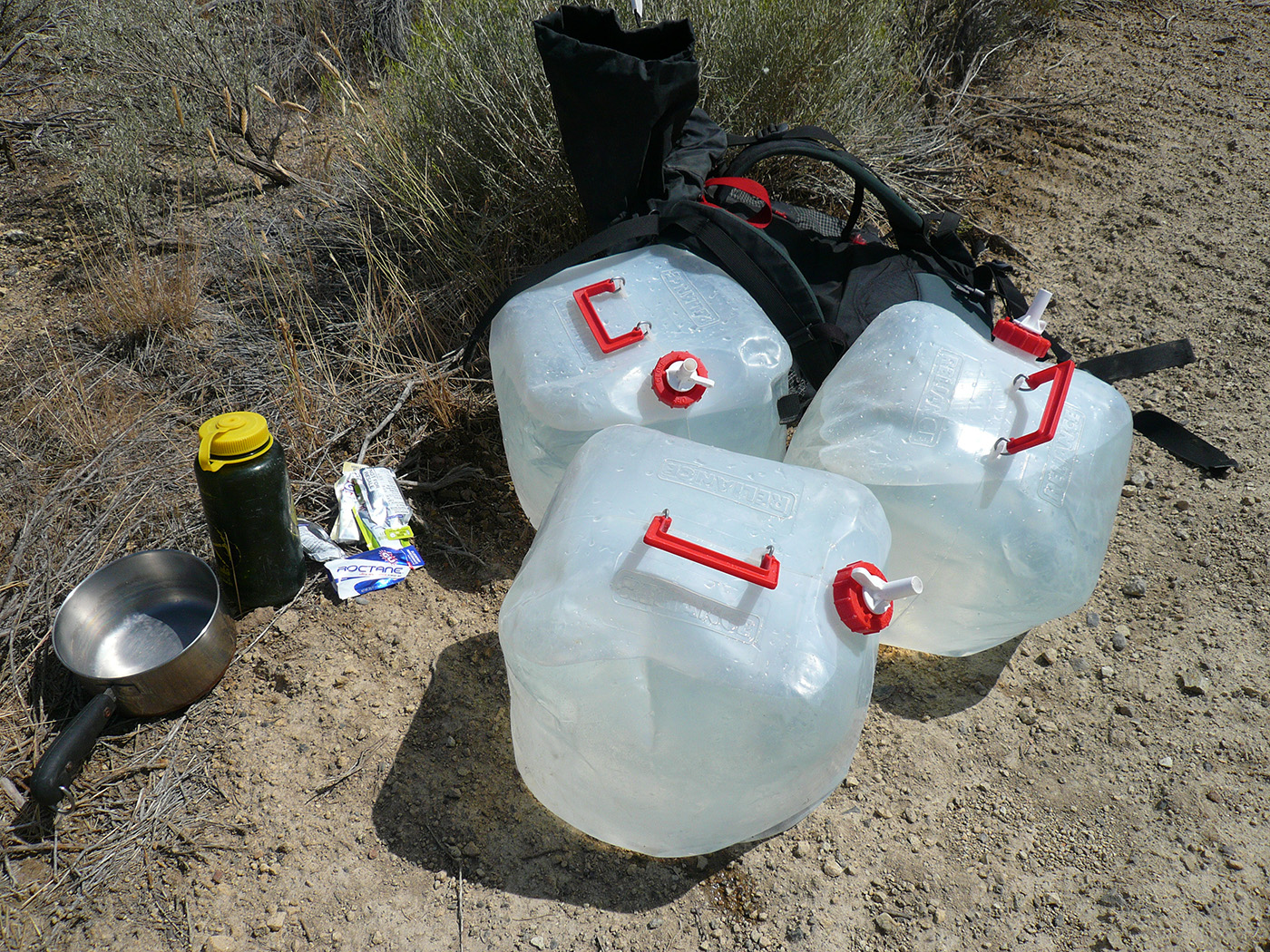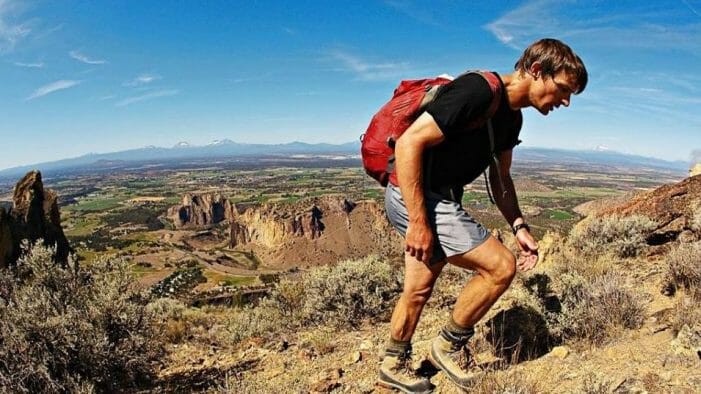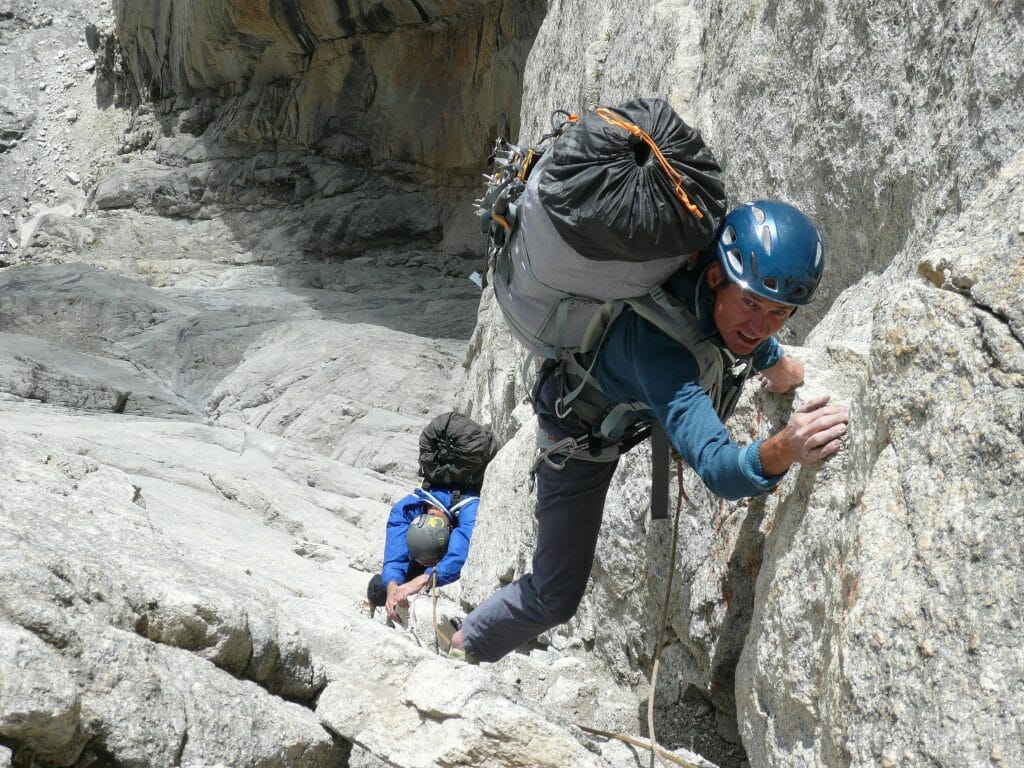Why is that some alpinists can ascend 1,000 meters in an hour with a 15-kilogram pack when others struggle with 1,000 feet in an hour? What is it that confers this seemingly superhuman ability to cover vertical terrain? Simply put, it’s muscular endurance (ME), sometimes referred to as strength endurance. Muscular endurance training is of utmost importance to all athletes involved in cyclic sports (ones that use repetitive movements for locomotion) lasting over 30 seconds.
Famed Russian coach and researcher Yuri Verkhoshansky was one of the first to explore and leverage this quality’s impact on sport performance. He defines ME as the capacity to maintain a high percentage of muscle contractile force for many repetitions of the propelling movement.
Why Should You Program Muscular Endurance Training?

Marko and Vince following day 3
In events that are highly dependent on the aerobic system (anything lasting more than 2 minutes), the ability of the muscles to make maximal use of the available oxygen supplied to them is as important as the heart’s ability to deliver sufficient oxygen to the muscles. Verkhoshansky’s own research showed that ME is the main determinant of an athlete’s maximum sustainable speed in efforts lasting more than a few minutes. This is often and confusingly referred to as the Anaerobic Threshold (AnT), Lactate Threshold, Maximum Lactate Steady State, and more recently Critical Power or Functional Power—a bewildering array of names for what essentially amounts to the quality we call endurance: the ability to maintain high power outputs for extended periods of time, often hours on end.
Alpinists and Mountaineers are almost totally reliant on their aerobic engines at higher altitudes. They must also carry substantial weight for a period of hours, making improving ME very important for those looking to move faster on steep terrain.
We have developed a simple variant of Verkhoshansky’s ME training ideas, using it very successfully for many years to prepare alpinists and big mountain climbers for their objectives. Our own experience supports Verkhoshansky’s research findings. This training needs to be a part of every serious training plan for those headed into the vertical world.
Remember: The ability of the working muscles to utilize the Oxygen delivered to them by the heart will be the limitation to your endurance when hiking/climbing steeply.
How to Train Muscular Endurance
There are literally as many ways to skin this cat as your imagination can conjure. We’ve tried many, many variants and have arrived at some simple guidelines we use with all our athletes. But first, this important warning:
MUSCULAR ENDURANCE TRAINING CAVEAT:
This stuff really works—and it works fast. Keep in mind that the higher your basic aerobic capacity, your Aerobic Threshold (AeT), the bigger the gains will be from this training. This is why we continue to beat the aerobic capacity drum so hard and so often. The excitement of seeing rapid gains when using these ME workouts often leads many folks to overemphasize them in their training program by replacing time spent training easier aerobic paces (Recovery and Zones 1 and 2) with these “money” workouts.
DO NOT make this mistake. You MUST maintain your lower-intensity aerobic volume and add this training on top of that. If you don’t, the gains you see will be quick (10–20 percent in only a few workouts) followed at first by a plateau and later a decline in performance.
We cover this in depth in our book Training for the New Alpinism and in articles on training (eg. “Death by (Anaerobic) Threshold”).
Bearing in mind the above warning, after you have gone though an extensive (how extensive? See note below) aerobic base-building period and elevated your Aerobic Threshold to it highest level for the current training cycle, you are ready to start adding some ME training to your program.
We like to see our athletes have their AeT be within 10 percent of their AnT as measured by heart rate before they begin this program.
If you are aerobically deficient, then you still have big gains to make by focusing on your aerobic system, which will make this training more effective. See our article on aerobic and anaerobic self-assessment for more.
The simplest way to increase the ME training effect of your workouts is to add resistance while doing some of your high-intensity (Z3–Z4) workouts. Our favored way of doing this is to use water jugs in a backpack so that the water can be dumped out at the top and you won’t beat your legs up so badly while coming down. (Note: Some climbers will find great benefit from carrying the weight down steep hills as well for the strength and stability training it affords, but if you do this know that your knees may suffer for it.)
While you can get decent gains using this method in Z1 and Z2, we prefer to make use of the higher aerobic zone to target the maximum pool of motor units you can recruit for the full extent of the workout. This seems to give the biggest gains. We also recommend doing these sessions in a sport-specific manner. For example: While you could do (and we have done) this workout by standing up in a big gear while riding your bike uphill and see gains, we instead suggest hiking steep uphills (as steep as you will be climbing) to maximize the sport-specific muscle recruitment patterns.
The Theory Behind ME: Hypergravity
The point of adding the extra weight is to increase the recruitment of the working muscle’s motor units. Your brain will increase the mass of muscle recruited as needed to get the job done, up to the point of maximal strength. The extra weight causes motor units that are not well endurance trained to be called upon to assist in getting the job done. This recruitment will expose these fibers to an endurance training stimulus that they don’t normally see. Recall from Training for the New Alpinism that if you can’t recruit them, you can’t train them. Due to these fibers’ relatively poor endurance (aerobic) capacity, they will be what determines your AnT heart rate for this type of work. If it is done correctly, that heart rate will be lower than your unweighted AnT heart rate.
ME Intensity Guide
The first thing you may notice is that your heart rate will not be a great guide for intensity when doing these workouts. We may call it Zone 3, but your heart rate will very likely be lower than normal Z3 while the leg work will feel much higher. THAT’S perfect. That is just what we are looking for in these workouts. You want the limitation to come from your muscles and not feel like you are running out of breath. A great gauge we use is that you should be able to carry on a conversation while your legs are burning. The effort should feel sustainable but just barely so, and if you went any harder your legs would give out in a few seconds.
To find this sweet spot of intensity requires that you adjust the steepness of the hill and the weight on your back. It will take some doing and everyone is different.

Water jugs and other tools used during ME water carries.
How Much Weight?
This depends on your state of fitness and goals for the workout. We can only give general guidance here, and you will need to adjust accordingly. Normally we start folks out with 5–10 percent of body weight if they have no experience with this type of training and are relatively new to hard aerobic work. Many very fit climbers feel comfortable with a 10–30 percent of body weight load. The final goal for this sort of training progression should be carrying loads at above the weight you’ll have on the climb.
How Steep?
Your locale will need to be factored in, but it is no excuse. In general, steeper is better for this effect (the more it looks like your climb’s terrain the better, but not absolutely necessary). Low-angle hiking trails are not very effective. We have had good success using slopes ranging from 30–100 percent grades (17–45 degrees). Sixty percent is a slope on which you can just barely reach out to stabilize yourself for balance with your hand while only slightly bending forward at the waist. Ski/hiking poles can be helpful for balance.
Steve House used this training method in his peak preparation periods on steep slopes and long third-to-low-fifth-class rock climbs where he felt comfortable climbing without a rope. We have also used this very effectively with guides training for their alpine and ski exams.
These workouts can be done as continuous Z3 efforts (remember, they will feel like Z3 even if your heart rate is not in Z3) or as long repetitions done Interval style. The length of your hill may require many laps or one single long push to the top.
We’ve used both methods and both are effective. If you have the luxury of training in alpine terrain, you can do these workouts front-pointing up steep slopes, like David Goettler does around Chamonix. But if you are stuck in Manhattan, you can avail yourself of the local vertical terrain by doing laps in tall buildings, like David Roeske did before knocking off both Cho Oyu and Everest without oxygen inside of three weeks. The most common barriers to effective training are motivation and imagination.
How Much Vertical?
That is the $64,000 question, isn’t it? As with all training there is no good stock answer. What might barely budge the training needle off zero for Steve House might exhaust another less fit climber. We suggest some very broad and simple guidelines for a progression of this kind of training in Training for the New Alpinism.
Ideally we’d like to end up with the final workouts encompassing more vertical and more weight than will be covered and carried on the biggest day of the upcoming climb. This holds true for those who are training at low elevations and whose ME training days do not include any technical terrain. If you are doing this type of work above 3000 meters, then adjustments need to be made.
Muscular Endurance Training Progression

Steve House hiking a 1,500-meter ridge while carrying 40 pounds of water at Smith Rock, near his home in Terrebonne, Oregon, on September 3, 2008, before his attempt on Makalu. He hiked the ridge three times that morning, each time with 40 pounds of water in his pack.
It is important to use this training in a structured, progressive manner. You’ll be doing 6–10 of these workouts over the course of a couple of months; the training stimulus needs to increase gradually as you adapt to the new loads. We like to progress either the weight or the volume (total vertical) in a stairstep fashion—and not both at the same time. Beginners to this will need to be cautious. Experienced climbers using this progression for the second or third time can push ahead harder as they know their previous limits.
A typical ME progression will include one workout a week and last about six to eight weeks. Due to the duration and heavy muscular loading of these workouts, fitting additional high-intensity training into the week will only be possible for athletes with an extensive background in this sort of high-intensity work. Allow at least three days of easy recovery workouts after each ME workout to start with as you learn how your body reacts to these. As mentioned earlier, you MUST maintain your aerobic base during this period or you will actually de-train. This training block is best used during the late Base Period and into the specific preparation period.
Notes
Note 1: Yuri Verkhoshansky. Block Training System for Middle Distance Runners
Note 2: Relationships of the Anaerobic Threshold with the 5km, 10km and 10 mile Races. Kumagai et al. European Journal of Applied Physiology (1982) 49:13-23
Note 3: Anaerobic Threshold: Its Concept and Role in Endurance Sport. Ghosh. Malaysian Journal of Medical Sciences (ISSN: 1394-195X) Vol 11 Num. 1.

